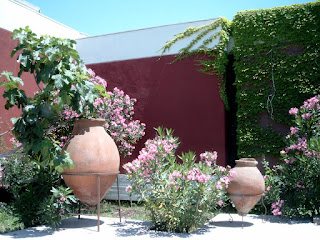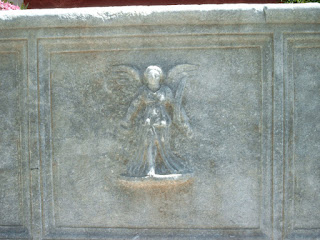The entrance to the archaeological museum in Canakkale.
You are not allowed to use a camera inside the building,
only in the courtyard outside the museum.
Two ancient containers on display in the courtyard in front of the museum.
Two ancient columns.
An ancient sarcophagus.
Detail of the ancient sarcophagus.
A Corinthian capital.
Two sarcophagoi with beautiful reliefs on the sides.
Detail of the sarcophagus.
Detail of the sarcophagus.
Notice the Greek inscription next to the portrait of the woman.
An ancient statue base with a Latin inscription:
CIL 03 - 00384 and ILS 1018.
CIL 03 - 00384 and ILS 1018.
The ancient statue base with a Latin inscription,
discovered in Alexandria Troas (in present-day Turkey).
The inscription is about Sextus Quinctilius Valerius Maximus,
who was a friend of Pliny the Younger.
discovered in Alexandria Troas (in present-day Turkey).
The inscription is about Sextus Quinctilius Valerius Maximus,
who was a friend of Pliny the Younger.
This picture shows the first part of the Latin inscription.
This picture shows the second part of the Latin inscription.
Here is the Latin text:
SEX(to) QUINCTLI(o)
SEX(ti) F(ilio) ANI(ensi) VALERIO
MAXIMO LATO CLAVO
EXORNATO A DIVO AUG(usto)
NERVA QUAESTORI PONT(i)
ET BITHYNIAE PATRONO
COLONIAE PONTIFICI II
VIRO PRAEF(ecto) FABRUM
II VIRALIB(us) ET SACERD(otalibus)
ORNAM(entis) HONOR(ato)
D(ecreto) D(ecurionum)
VIC(us) X
In English:
"To Sextus Quinctilius Valerius Maximus, son of Sextus, (of the tribe) Aniensis, adorned with the broad purple stripe (i.e. senatorial status) by the deified Nerva, quaestor of Pontus-Bithynia, patron of his colony, pontifex, duovir, prefect of the fabri, honored with duoviral and priestly ornaments by the decree of the decurions.
(This monument was erected by) the tenth district."
Here is the Latin text:
SEX(to) QUINCTLI(o)
SEX(ti) F(ilio) ANI(ensi) VALERIO
MAXIMO LATO CLAVO
EXORNATO A DIVO AUG(usto)
NERVA QUAESTORI PONT(i)
ET BITHYNIAE PATRONO
COLONIAE PONTIFICI II
VIRO PRAEF(ecto) FABRUM
II VIRALIB(us) ET SACERD(otalibus)
ORNAM(entis) HONOR(ato)
D(ecreto) D(ecurionum)
VIC(us) X
In English:
"To Sextus Quinctilius Valerius Maximus, son of Sextus, (of the tribe) Aniensis, adorned with the broad purple stripe (i.e. senatorial status) by the deified Nerva, quaestor of Pontus-Bithynia, patron of his colony, pontifex, duovir, prefect of the fabri, honored with duoviral and priestly ornaments by the decree of the decurions.
(This monument was erected by) the tenth district."
* * *













No comments:
Post a Comment